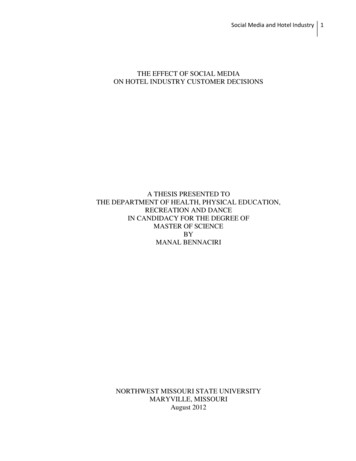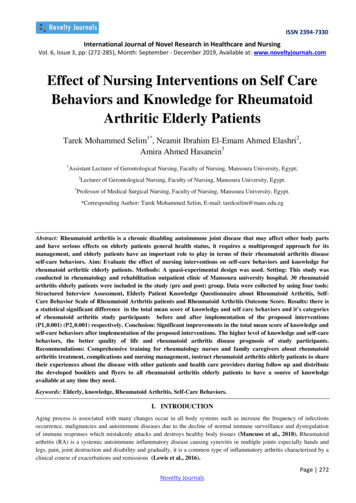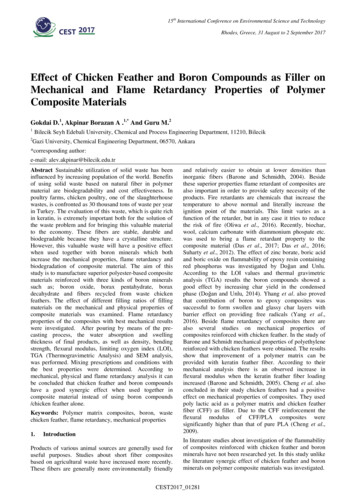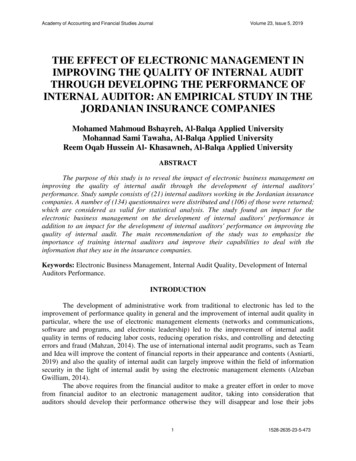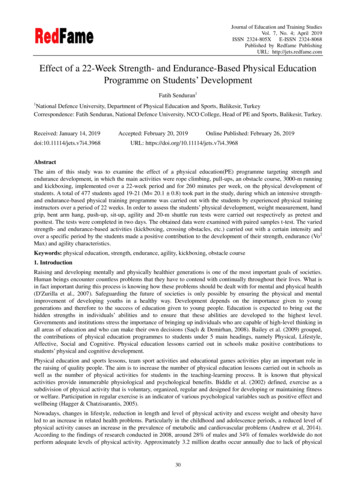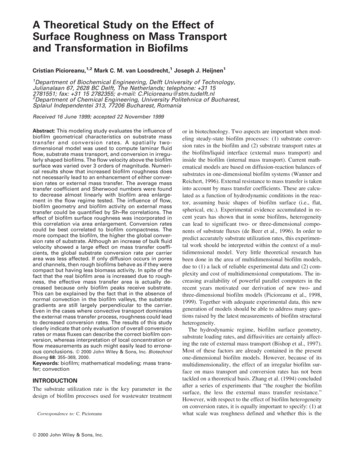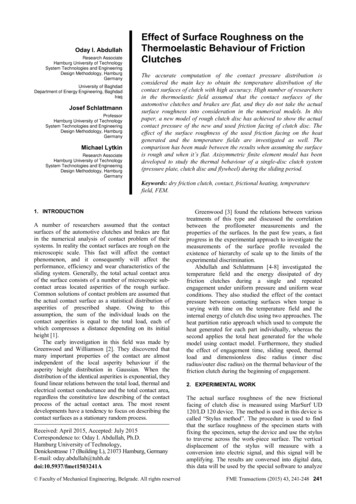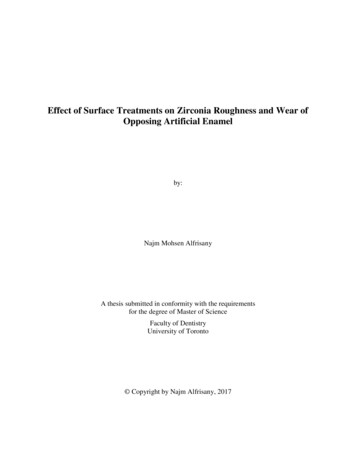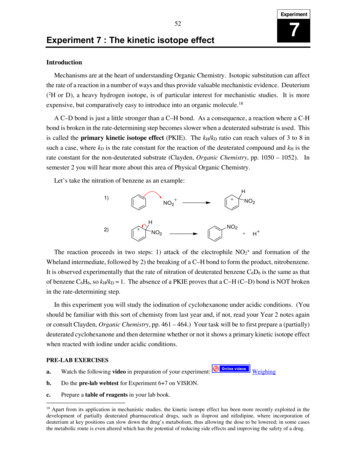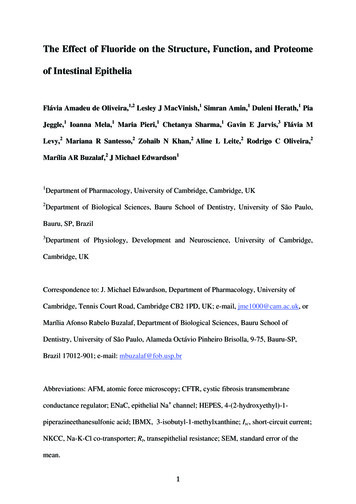
Transcription
The Effect of Fluoride on the Structure, Function, and Proteomeof Intestinal EpitheliaFlávia Amadeu de Oliveira,1,2 Lesley J MacVinish,1 Simran Amin,1 Duleni Herath,1 PiaJeggle,1 Ioanna Mela,1 Maria Pieri,1 Chetanya Sharma,1 Gavin E Jarvis,3 Flávia MLevy,2 Mariana R Santesso,2 Zohaib N Khan,2 Aline L Leite,2 Rodrigo C Oliveira,2Marília AR Buzalaf,2 J Michael Edwardson11Department of Pharmacology, University of Cambridge, Cambridge, UK2Department of Biological Sciences, Bauru School of Dentistry, University of São Paulo,Bauru, SP, Brazil3Department of Physiology, Development and Neuroscience, University of Cambridge,Cambridge, UKCorrespondence to: J. Michael Edwardson, Department of Pharmacology, University ofCambridge, Tennis Court Road, Cambridge CB2 1PD, UK; e-mail, jme1000@cam.ac.uk, orMarília Afonso Rabelo Buzalaf, Department of Biological Sciences, Bauru School ofDentistry, University of São Paulo, Alameda Octávio Pinheiro Brisolla, 9-75, Bauru-SP,Brazil 17012-901; e-mail: mbuzalaf@fob.usp.brAbbreviations: AFM, atomic force microscopy; CFTR, cystic fibrosis transmembraneconductance regulator; ENaC, epithelial Na channel; HEPES, 4-(2-hydroxyethyl)-1piperazineethanesulfonic acid; IBMX, 3-isobutyl-1-methylxanthine; Isc, short-circuit current;NKCC, Na-K-Cl co-transporter; Rt, transepithelial resistance; SEM, standard error of themean.1
ABSTRACT: Fluoride exposure is widespread, with drinking water commonly containingnatural and artificially added sources of the ion. Ingested fluoride undergoes absorptionacross the gastric and intestinal epithelia. Previous studies have reported adversegastrointestinal effects with high levels of fluoride exposure. Here, we examined the effectsof fluoride on the transepithelial ion transport and resistance of three intestinal epithelia. Weused the Caco-2 cell line as a model of human intestinal epithelium, and rat and mousecolonic epithelia for purposes of comparison. Fluoride caused a concentration-dependentdecline in forskolin-induced Cl- secretion and transepithelial resistance of Caco-2 cellmonolayers, with an IC50 for fluoride of about 3 mM for both parameters. In the presence of 5mM fluoride, transepithelial resistance fell exponentially with time, with a t1/2 of about 7 h.Subsequent imaging by immunofluorescence and scanning electron microscopy showedstructural abnormalities in Caco-2 cell monolayers exposed to fluoride. The Young’smodulus of the epithelium was not affected by fluoride, although proteomic analysis revealedchanges in expression of a number of proteins, particularly those involved in cell-celladhesion. In line with its effects on Caco-2 cell monolayers, fluoride, at 5 mM, also hadprofound effects on Cl- secretion and transepithelial resistance of both rat and mouse colonicepithelia. Our results show that treatment with fluoride has major effects on the structure,function, and proteome of intestinal epithelia, but only at concentrations considerably higherthan those likely to be encountered in vivo, when much lower fluoride doses are normallyingested on a chronic basis.Keywords: fluoride; epithelial ion transport; gastrointestinal epithelia; atomic forcemicroscopy; cell stiffness; proteomics2
INTRODUCTIONFluoride exposure is common worldwide. The anion occurs naturally and is also commonlyadded to drinking water, with current World Health Organization guidelines (2006)recommending levels of 1.5 mg/L. Dental caries is a significant healthcare problem,occurring in 46% of 15 year-olds in the UK, for example (Murray et al., 2015), and fluorideis widely known for its beneficial effects in combating this condition (Parnell et al., 2009).Inadequate levels of exposure to fluoride ( 0.5 mg/L in drinking water) can result inincreased predisposition to caries, while excessive intake is associated with dental, and athigher levels, skeletal, fluorosis (McDonagh et al., 2000). Although, water is often thepredominant source of intake, dental hygiene products, food and teas can also contribute tofluoride ingestion (Fawell et al., 2006). Importantly, levels of fluoride exposure areinconsistent worldwide, with many countries such as India and China reporting endemicfluorosis (Jolly et al., 1969; Lyth, 1946) as a result of naturally elevated levels in drinkingwater.Ingested fluoride undergoes rapid gastric absorption in a pH-dependent manner, as aresult of the high lipid solubility of hydrogen fluoride (Gutknecht and Walter, 1981), andincreasing acidity increases the rate of uptake (Whitford and Pashley, 1984). Other factors,such as recent food consumption or dietary calcium consumption, can limit fluorideabsorption (Whitford, 1994). The remaining fluoride is mostly absorbed in the small intestine(Nopakun et al., 1989), with a rate independent of pH (Buzalaf and Whitford, 2011).Gastrointestinal toxicity has been observed with fluoride, and gastrointestinal symptoms havebeen reported in cases of skeletal fluorosis (Dasarathy et al., 1996). Chronic ingestion offluoride has also been correlated with histologically observable damage to the gastricepithelium (Das et al., 1994). These studies, although small-scale, indicate that further studyof the potential adverse effects of fluoride on the gastrointestinal tract is warranted.3
The intestinal epithelium is highly specialized, with distinct apical and basolateraltransporters, and this functional polarization facilitates a broad range of absorptive andsecretory functions (Cuthbert et al., 1999). Na acts as the lead ion for absorption, with theNa /K -ATPase producing an inward electrochemical gradient for Na . This gradient enablesdiffusion of Na into the cell through epithelial Na channels, which is accompanied by Cland water movement. The Na-K-Cl co-transporter (NKCC1) moves Cl- ions into the cell viasecondary active transport, coupled with Na and K . K then passes through basolateral K channels, which hyperpolarizes the cell, thereby increasing the driving force for Cl- exit. Clsecretion through apical Ca2 -activated chloride channels and the cystic fibrosistransmembrane conductance regulator (CFTR) is accompanied by Na and water (Barrett andKeely, 2000). Elevations of intracellular cAMP promote secretory mechanisms by actions onCFTR, NKCC1 and the basolateral KvLQT1 K channel (Cuthbert et al., 1999).Tight junctions between gastrointestinal epithelial cells form a continuous barrierbetween apical and basolateral cell surfaces, and control transport via the paracellularpathway (Balda et al., 1992). Tight junctions determine the integrity and core physiologicalproperties of epithelia, such as the nature of molecules and ions that can diffuse across. Theirregulation allows these epithelial properties to undergo dynamic changes (Matter and Balda,2003). Tight junction complexes are composed of three key components: integral proteins,such as zona occludens-1 (ZO-1), that traverse the intercellular space, plaque proteins thatjoin the integral proteins to the cytoskeleton, and a diverse range of multifunctionalnuclear/cytosolic proteins (Schneeberger and Lynch, 2004). The ‘tightness’ or permeabilityof these junctions to ions is often measured via transepithelial resistance (Rt). As a result ofthe need for extensive absorption and secretion, the gastrointestinal tract has a relatively lowRt, with the exception of the terminal colonic regions (Anderson and Van Itallie, 2009).4
The concentrations of fluoride required to produce toxic effects on the gastrointestinaltract, and importantly whether such concentrations are reached in vivo, are unclear. Here, westudied the effects of fluoride on the structure, function, and proteome of a model colonicepithelial cell line, the human Caco-2 cell line, and also on transepithelial ion transport in ratand mouse colonic epithelia. We observed profound structural and functional effects offluoride; however, these effects were produced at fluoride concentrations that are unlikely tobe encountered in vivo.MATERIALS AND METHODSCell CultureCaco-2 cells were cultured in Dulbecco’s Modified Eagle’s Medium (Life Technologies),containing 10% fetal bovine serum, 1% penicillin and 1% streptomycin at 37 C in anatmosphere of 5% CO2/95% air. For polarized monolayer formation, cells were seeded intoSnapwell inserts (Corning), which contained a 12-mm diameter polycarbonate membranewith 0.4-µm diameter pores. Inserts were placed in 6-well plates with 1.5 mL and 4 mL ofmedium on the apical and basolateral sides of the monolayers, respectively. Cells werecultured for 14-16 days to allow the formation of a tight, polarized epithelium. Note thatalthough the Caco-2 cell line was originally derived from a human colon adenocarcinoma,the characteristics of the cells in culture depend heavily on culture conditions and are oftenmore similar to those of small intestinal enterocytes (Sambuy et al., 2005). For this reason,we regard the Caco-2 cell monolayers as a model of a human intestinal epithelium in general,rather than of a colonic epithelium in particular.Preparation of Rat and Mouse Colonic EpitheliaWild type rats and mice of mixed weight, age and sex were used to provide sections ofcolonic tissue. Following cervical dislocation, the peritoneum was dissected away; the colon5
was removed and the tissue was maintained in aerated (5% CO2/95% O2) Krebs-Henseleitsolution (117 mM NaCl, 4.7 mM KCl, 2.5 mM CaCl2, 1.2 mM MgSO4, 1.2 mM KH2PO4,24.8 mM NaHCO3, 11.1 mM glucose, pH 7.4). The section of colon below the caecum wasdivided into three or four 1.5-cm segments, which were incised along the mesenteric line.The serosa and muscularis mucosae were then removed using watchmaker’s forceps.Measurement of Transepithelial Ion Transport and ResistanceVoltage clamps (DVC-1000 Epithelial Voltage/Current Clamp, World Precision Instruments)were calibrated before each experiment (Input/Offset and Fluid RES compensation set to 0.0).Snapwell inserts with confluent Caco-2 cell monolayers were transferred to Ussingchambers (Ussing and Zerahn, 1951) with a 1.13 cm2 aperture (World Precision Instruments).For colonic epithelia, the aperture was 0.2 cm2. The monolayers or epithelia were bathed onboth apical and basolateral sides with 20 mL of Krebs-Henseleit solution at 37 C, andcontinuously aerated with 5% CO2/95% O2. Chambers were left for 10-30 min to equilibrateonce voltage clamping had begun. PowerLab 2/25 software (ADInstruments) was used torecord the short-circuit current (Isc) across the epithelium, with one data point per secondplotted on continuous axes of Isc versus time. All traces were recorded using PowerLabhardware with LabChart software, and data were analysed using Microsoft Excel software.Transepithelial resistance (Rt) was measured via changes in Isc during 5-s pulses to a 2-mVtransepithelial voltage every 30 s, according to Ohm’s law, (Rt V/I). 3-isobutyl-1methylxanthine (IBMX; Sigma), amiloride (Sigma) and furosemide (Sigma) were dissolvedin water, while forskolin (Calbiochem) was dissolved in 95% ethanol. Drugs were diluted toappropriate final concentrations in Krebs-Henseleit solution.Data Analysis6
All traces were viewed on a LabChart Reader, and data were recorded in a Microsoft Excel2013 spreadsheet for further analysis. For all data, mean and standard error of the mean(SEM) were calculated.Concentration-response curves for the effects of fluoride or forskolin on ΔIsc and for theeffect of fluoride on Rt were plotted in Excel 2013. Data were fitted to the following 4parameter logistic equation using the maximum likelihood approach:E Min MaxnH A 1 pIC50 10 Maxwhere E is the response (ΔIsc or Rt), [A] is [NaF] or [forskolin], Min is the response when[A] 0, Max is the response when [A] , pIC50 -log(IC50),and nH is the Hill Coefficient.For these data an additional model was used for the residual error variance (RUV):RUVi 2 yˆ i where RUVi is the residual unexplained variance for data point I, 2 is a variance parameter,andiis the modeled response for data point i. defines the relationship between residualerror and response; e.g. when 0, residual error is constant (i.e. homoscedastic) and when 2, the standard deviation of the residual error is directly proportional to the response (i.e.the coefficient of variation is a constant).The Excel Solver function was used to minimize the value of extended least squares to fitthe curves, integrating both of the above models. GraphPad Prism 6 or 7 was used to plotexponential decline curves of Rt and ΔIsc in time-course experiments, to carry out linearregression and to compare data sets with unpaired t-tests. Two-way ANOVA tests withBonferroni’s post-hoc tests were used to compare the difference in means between controland fluoride exposure data for experiments on colonic epithelia. One-way ANOVA tests with7
Tukey’s post-hoc tests were used to determine how means changed during each protocol.Significance was taken at P 0.05.Scanning Electron MicroscopyCell monolayers on polycarbonate membranes (excised from Snapwell inserts) andsupported on coverslips were quench-frozen by plunging, cell face first, into melting propanecooled in liquid nitrogen. Monolayers were freeze-dried in a modified Edwards 306 Auto 306carbon coating unit (Warley and Skepper, 2000). After drying, the cells were coated withcarbon and attached to scanning electron microscopy stubs with colloidal silver. The cellswere coated with 10 nm of gold in a Quorum/Emitech K575X sputter coater and viewed in anFEL-Philips XL30 FEGSEM at 5 kV.ImmunofluorescenceCell monolayers were fixed in 4% paraformaldehyde in phosphate-buffered saline, andpermeabilized by treatment with 0.05% saponin in the same buffer containing 0.2% gelatin.Monolayers were incubated in permeabilization buffer containing rat monoclonal anti-zonaoccludens-1 (ZO-1) monoclonal antibody (eBioscience), followed by fluoresceinisothiocyanate-conjugated rabbit anti-rat secondary antibody (Sigma). The cells were thensubjected to fluorescence microscopy.Measurement of Young’s ModulusThe stiffness of living Caco-2 epithelial cell monolayers, as represented by their Young’smodulus, was determined using an atomic force microscopy (AFM) nano-indentationtechnique (Heinz and Hoh, 1999; Kasas and Dietler, 2008). The Young’s modulus wascalculated via the force that had to be exerted to indent the cell membrane by a fixed distance.Measurements were conducted at room temperature using a scanning probe microscope(BioScope I SPM, Bruker) integrated into an inverted microscope (Axiovert 135, Zeiss).8
Cell monolayers growing in 6-well culture plates were washed with 4-(2-hydroxyethyl)-1piperazineethanesulfonic acid- (HEPES)-buffered saline solution (135 mM NaCl, 5 mM KCl,1 mM MgCl2, 1 mM CaCl2, 10 mM HEPES, pH 7.4) and bathed in the same solution duringexperiments. Measurements were performed using soft cantilevers (spring constant, 20pN/nm; Novascan) with a polystyrene sphere (diameter, 10 µm) as the tip. A maximalloading force of 10 nN was applied. For each monolayer, 9 cell areas were chosen and 25force-distance curves were collected for each area. AFM data were collected with NanoScopesoftware 5.31 (Bruker). Young’s modulus values were calculated from force-distance curvesusing AtomicJ Software (Hermanowicz et al., 2014). Average Young’s modulus values werecalculated for each cell area, and these values were in turn averaged to produce a single valuefor each monolayer. Four monolayers were analysed for each condition (i.e. with or withoutfluoride treatment).Proteomic Analysis of Caco-2 CellsCaco-2 cell monolayers were either untreated (control) or exposed to 5 mM fluoride (as NaF)for 24 h. Experiments were conducted in quintuplicate. Membrane proteins were extractedusing a Mem-PER eukaryotic membrane protein extraction kit (Thermo Scientific). Thefraction containing hydrophobic proteins was collected and the proteins were purified usingdetergent removal spin columns (Thermo Scientific). Proteins were extracted, reduced,alkylated and digested as previously described (Antonio et al., 2017), and then analyzedusing a nanoAcquity UPLC-XEVO QToF mass spectrometry system (Lima Leite et al.,2014). Differences in expression between the groups were assessed using PLGS software andexpressed as P 0.05 for down-regulated and (1-P) 0.05 for up-regulated proteins. Functionalenrichment was analysed using ClueGo, a Cytoscape plugin. For each comparison,bioinformatics analysis was performed, as described previously (Orchard, 2012; BauerMehren, 2013; Millan, 2013; Lima Leite et al., 2014).9
RESULTSEffect of Fluoride on Caco-2 Cell MonolayersCaco-2 cells were cultured for 14-16 days on polycarbonate membranes to produce polarizedmonolayers, and transepithelial ion transport was measured using short circuit current (Isc)recordings in Ussing chambers. Addition of forskolin (10-5 M) to both sides of the monolayer,in the presence of the phosphodiesterase inhibitor IBMX (10-4 M), was used to elevateintracellular cAMP concentration. Forskolin treatment caused a transient rise in Isc (asterisk),through a cAMP-dependent stimulation of Cl- transport via CFTR [Fig. 1(A)]. The transientnature of the effect of forskolin on Caco-2 monolayers has been observed previously (Zhu etal., 2005; Jantarajit et al., 2017) and may be a result of a lack of hyperpolarising K channelsin the basolateral membrane, which sustain prolonged secretory responses in other epithelia(see below). The forskolin-stimulated Isc in untreated monolayers (transporting area 1.13 cm2)was typically about 2 A/cm2, and the transepithelial resistance was about 350 Ω cm2.Preincubation of the monolayers in medium containing various concentrations of fluoride for48 h resulted in a concentration-dependent reduction in forskolin-stimulated Isc [Fig. 1(B)],with an IC50 for fluoride of 3.1 mM (95% confidence interval, 2.9-3.3 mM). Transepithelialresistance (Rt) was also reduced in a concentration-dependent manner by fluoride treatmentover a 48-h period [Fig. 1(C)], with an identical IC50 of 3.1 mM (95% confidence interval,2.6-3.7 mM). The time-course of the effect of fluoride (5 mM) on Rt was exponential, with at1/2 of 7.08 2.98 h [Fig. 1(D)].To probe the effect of fluoride on the fine structure of the Caco-2 cell monolayer, weused scanning electron microscopy. Confluent monolayers were either untreated or treatedfor 48 h with 5 mM fluoride, conditions that reduced transepithelial resistance to zero (seeabove). Typical scanning electron micrographs are shown in Fig. 2. As can be seen, the apical10
surface of the control monolayer was almost flat, although individual cells could just bediscerned [Fig. 2(A)]. In contrast, the surface of the fluoride-treated monolayer was highlydisrupted, with apparent gaps in the monolayer and the presence of rounded cells [Fig. 2(B)].This observation suggested that the tight junctions between the cells might have beendisrupted by fluoride treatment. To test this possibility, we examined the distribution of thetight junction protein ZO-1 by immunofluorescence [Fig. 3]. We found that the controlmonolayer had a regular pavement-like appearance, with polygonal staining for ZO-1 [Fig.3(A)]. In contrast, the fluoride-treated monolayer showed a more irregular ZO-1 stainingpattern [Fig. 3(B)]. Further, the polygons bounded by ZO-1 were larger than in the controlmonolayer and often enclosed more than one cell, as indicated by the nuclei that were visiblein the image (arrows). Fluoride, therefore, disrupted the tight junction arrangement in Caco-2cell monolayers.We also examined the effect of fluoride on the Young’s modulus of Caco-2 epithelia bynanoindentation using AFM. Cell monolayers growing in plastic culture dishes were eitherincubated with 5 mM fluoride for 48 h or left untreated. At the end of the incubation period,the mechanical properties of cells within the monolayers were measured using AFM probeswith spherical tips as mechano
increased predisposition to caries, while excessive intake is associated with dental, and at higher levels, skeletal, fluorosis (McDonagh et al., 2000). Although, water is often the predominant source of intake, dental hygiene products, food and teas can als

